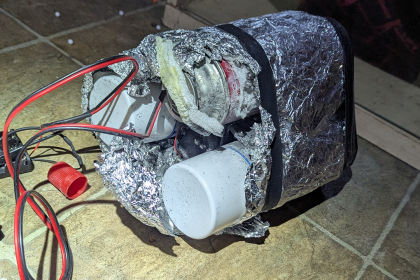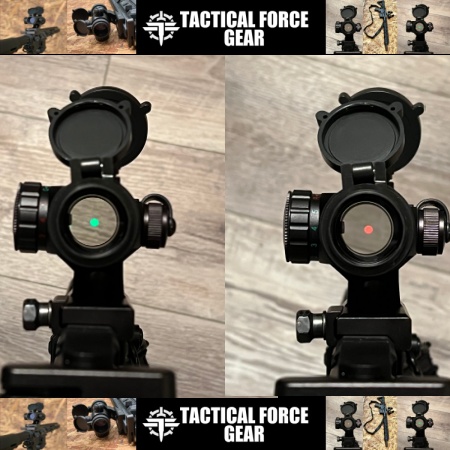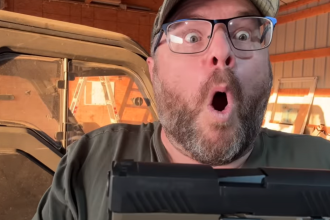So, there’s this new book I am working on – the first part is due to hit Peoplenomics next week. It’s about how “People Are Products” and how we are each uniquely genetically coded to do certain things.
As I was working in my shop, I was struck by the high level of tactility evidenced in the shop. Everything thing out there is “touch”. The “hobby shop” area has several plastic models to be assembled – including a 3-foot-long model of the Constitution. Having been schooled by a master model-maker in Portland (hand-carved hulls of all the great sailing ships that he’d been crew aboard at the turn of the previous century) that ultra-slow, exacting detail level is extremely appreciated.
Even the selection of (Testor model) paint had to be right. Many ship modelers – great as they are – don’t remember – or perhaps never knew – that old square riggers were often plated with a yellowish brass alloy you may have never heard of: “Muntz Metal” which is a 60/40 copper/zinc. Comes up in precision model-making now and then at places like Vintage Billing Boats Cutty Sark – Sheathing the Hull? | Ships of Scale. Even the bottle version color isn’t presact, depending on how long you want the ship to appear to have been out of water…
Wikth winter almost over, model ship building may be moved to the back burner until the Depths of Hades in the summer. Point is? Well, we’re talking about Tactility today and how different personality types tend toward certain levels of engagement with their work. Physical – touchy stuff.
Gradations of Fineness
Tactility is somehow in the “decision-tree” even for a simple shop operation, like “Which saw to use?”
When you have a dozen and a half options, picking the right one can take time. Tactility is usually head-to-head with Time, for me. If Time is of the essence, it will be a power tool. If tactile experience is the higher priority, then a hand saw, it will be. Well, unless there is a quality aspect.
Take those times you have a general purpose 40-point carbide 10″ blade mounted in the table saw. Sure, you can slap on a 240-tooth hollow-ground blade. But, if the day’s planned work only involves one, maybe 3 fine-kerf cuts, a Japanese draw-knife can handle the job. But even here, the moisture of the wood can figure into it. Tear-out of the edges, things like that as you settle into your own “grade of work.”
Punching in holes is a different blend of tactility. Holes are holes, but it’s the jigging that matters. Again if Time is driving, off to the drill press. But more tactile is the Milescraft drill jig or perhaps a pocket hole jig. How about a centering jig for an edge hole, the eyeball with the board? Ah…touch.
Carries into Hobbies: The Ham Radio Example
Tactility was bouncing between the eardrums this week when…I had noticed tactility recently as I was setting up the radio gear for a higher level of play in that area. Some radios, like the Icom M710 marine radio, recycled from a Gu8lf shrimper (with a Sel-Call unit for $125 bucks a while back) has very little tactile to recommend it. Set the channel, adjust volume if necessary, touch the clarifier maybe (receiver frequency adjustment) but rarely is it needed.
Just show up Sunday morning on 3806 around 6aM, grab the microphone and start yelling “Hey Larry! Geoff? Motorman? Alex? Ya’ll around today? John…is coffee goood?” Turn on the power and talk. Sip coffee. Get impatient and wonder off shortly after the howdies.
And that’s when I figured out my 60-year love affair with ham radio was really all about tactility. I can probable afford any radio ever made when comes down to it. (Almost bought a Signal One on eBay this week. But the high-end radios have mostly gone to menus, replacing knobs. Take the Omni VII. Yes, it sounds even better than some of the old tube-type gear. Of course! But, in place of knobs which you can fiddle with (it’s an ADHD thingy), it’s all down to software and menus.

This is why on ham radio, you will hear things like somone saying:
“Well on the Kenwood 590S, set your”Baud Rate:” to “115200” (That’s if you’re running the “S” model because on the SG’s there’s a different default value. Confirm in the TS-590S Menu
No.62 or TS-590SG Menu No.68.”
People never had to do that wityh knobs. The operator just needed “fiddle to fix this” or “faddle to fix that…” No soul in button punching/
Other of my “modern gear” is similarly afflicted with menu-itis. Kenwood TS-590S has separate transmit and receive equalizers, which are whole realms of “on the air” fiddle and addle (“How’s that sound, Larry?”), sure. But it’s not the same as having ongood earphones and adjusting the microphone gain and how you are “speaking across the mic” to get really great sound (without popping a pee…er…”P.”.
And talk about knobs? A whole armload of them on the old RME-6900 receiver!

Or the Dtake 2B with the Q-Multiplier…a perfecrt knob add-on if there ever was one!
And dialing someone in happens before we get to twisting the linear amplifier knobs…Especially fun are the ones with crank handles!

Let’s give spins and eye the meter of the antenna tuner. Another crank! A Roller inductor (coil) crank and two Big tuning and loading dials. Hell yeah!

See it? TOUCH. Twist, Fiddle, and Play! Not “poke and pray” for programming.
Twisting Tactility
Ham radio – when somehow it’s the tactility of it all – is a perfect blend of a Morse key tactile and sensory feedback – when pressed key, pressed slightly, dims the lights, makes a loud humming sound as the desk begins to shake…and you can feel the amplifier begin blowing off heat from the pair of 4-400A tubes that are taking the chill of the radio room. You can feel it.
Until the advent of transistors and (forgive me for saying it) chips, there wasn’t much reason for ham radio at all south of Oklahoma – at least in the tube days – until the dead of winter and then only to take the chill off.
Addiction to Checklists?
In one of my books, I went into the depths of how people can become “Victims of Process.” And the idea is that humans are “scheduled events” in a sense. While transceivers (with or without menus) are nice and easy to operate, there is no particular “art” to is. Point and shoot kinda thing.
Just tuning up the Gonset GSB-100 transmitter involves: 13 listed steps in the manual and “preliminary” which is followed by 5-steps to making sure you’re on the other station’s frequency. And then 13 more steps to get ready for SSB voice.
And no “power and antenna” is all you need on this transmitter. Try on wiring on the outside back that routes like this:

Now, Keyboards? Digital modes? Yeah, if you like typing, sure. But I do that all week. This tactile stuff matters, I tell you.
No sir, for me it’s the tactility of doing that’s the magic. The vibration of the desk as the power supply in the amp loads up. The sidetone of the raspy (Ne-2 relaxation oscillator) when Morsing around.
Which is why I concluded that a key learning area to get acquainted with on this “ride through life” is nailing down the “My Best levels (and areas) of Tactility” in your life. Some people are in Aikido, others are into tubes that glow in the dark. Mastering tactility is something, though – that’s a key to a happy (or learning-filled) life.
It goes in the same mental place-holder as finding the perfet angle of heel when taking a big sailboat to weather offshore. The boat gets “balanced” and will almost tend itself. Self-tacking jibs are cheating. Jury here (200 m. inland) is still pondering catamorons. (Stiks gets a pass.) Easier to call BS on 8-foot crank-down dagger boards on anything that floats..
Similarly, trimming the plane perfectly, so a slight body lean forward changes the center-of-gravity just so. On a couple of single-engine transcon’s we did just that. “Are you leaning back, or are we burning off fuel causing us to climb, dear?”
Radios are like that. A weird way of ADHD-oriented skilling. With an onboard A/D converter in your head for Morse code…
There’s a reason old-time hams called the “rice box riders” Appliance Operators But it’s extensible, see? In the shop why bother with the metal lathe if you have a 3D printer and some sintering filament you can send off to be reduced to an impossible to machine part? Well, except one is a skill. The other is more a print file and postage.
T/Q Explains a Lot
“Tactility Quotient” has managed to explain a huge swath of observations over 75-years of life that hadn’t previously made sense.
- Pappy Ure declined several requests (pleadings, really) to take the fire chief’s exam in Seattle. As the lead captain of a bordering-industrial station, he was “addicted to runs.” Being “first in” at a fire, going in with an “inch and a half hose” or repairing people injured in industrial accidents so they could be transported. His T/Q was very high.
- My son’s addiction to “high speed life” (and the EMS/Fire service) is also due, I think, to his tactility needs being super-high. I can’t think of any other reason to get out of an airplane at 16-thousand feet.
- Another uncle – one who rose to #2 in the Seattle FD – I noticed did more (and bigger) projects around his home, the higher he was promoted.
- And other people – like Jeff Bezos, who I understand had a grand shop, at one time – again, the hands on part of life.
Crazy Sunday Hypothesis:
Simply goes like this: While religions talk “father, son, and spirit” kinds of aspects of humanery, there seems to be an almost “automation-like subsystem” for each “aspect” (or, to Theosophical types, each ray lighting a person’s path).
Could there be a tie-in that goes “Hand work, head work, heart work” – and that all three must be recognized and honored in some manner?
“But how about when a hand work and a heart work merge, as they do in the martial arts?”
Damn-fine question – go ask Clif. I have a soldering iron to get back to…
The Radio Detective: SR-400 (2)
Works just great. I mean love it! Almost up to how my SX-101′s play or the SX-111. Figured out why I got such a marvelously low price when bid-sniped on eBay. Listen and learn, compadre!
See, many people don’t realize that on a lot of older ham radio gear, there will be a complex looking plug on the back of the (tube type base) on the set. A normal (8-pin) octal socket was used in a lot of gear, but others like Hallicrafters, Johnson, and some Heathkits tended to 11-pin plugs. (The 11 pin plugs that look like they should go into an octal plug, but won’t, and still called octals by knuckle-draggers of the ham radio art. (OCTAL means 8 – like in Ocho!)
The BIG secret *(not to be shared with non-readers, (on the order of Wuoff-Hang level stuff follows) is that a radio usually won’t work without this plug. Unlike the Wuoff-Hang which is not required for an antenna to work well…
Sometimes The SECRET PLUG dope is even “hidden” in the manuals. But with the SR400, it shows up in the schematic (below as the ‘accessory plug’) and you can see the jumper from pin 2 to pin 10. Radio won’t work without it.

Beer on the side says that’s why the SR-400 was so cheap. Now, if I could get the SR-2000 with the same oversight involved… (This is why we have a magnifier on the 4K display of eBay ham ad pictures!)
So, in place on the bench, see the tiny blue arrow for a hint where the plug goes:

The little red wire tells the radio to listen for frequency information on Pin-10. If you don’t have the accessory (remote VFO (frequency unit) HA-20, you’ll put that red wire in to the correct plug and you might be in business. (Or, you could let out smoke if you can’t count pins right…)
The key takeaway is to blow up the pictures (not the radio)( on eBay and see if (buying anything) you can spot some potential “easy to fix” solutions. Who knows, you might be able to turn a $150 “parts radio” into a “working” $500 dollar radio suitable for collectors.
Who don’t know about octal plugs.
Spring’s Coming
This weekend, the first batches of hydroponic seeds go in for the lean-to greenhouse. If it looks like no frost in the forecast, we will be able to harden them off in 3-4 weeks and get ’em in the ground early.
If we get frost in the forecast? Well, we’ll cross that bridge when we come to it. Remember, the Chineseum diesel heater is still in place. Only a 5-gallon jug of diesel, a new fuel line, and a priming await to make the greenhouse plantable. But to buy much more than occasional frost-abatement, cooling in the dead of winter didn’t make sense.
Especially with 32 stalks of romaine under grow lights in the recording studio.
Drop by next weekend for another chapter meeting of Excentrics Unlimited.
Write when you get rich,
George@Ure.net /ac7x
Read the full article here










